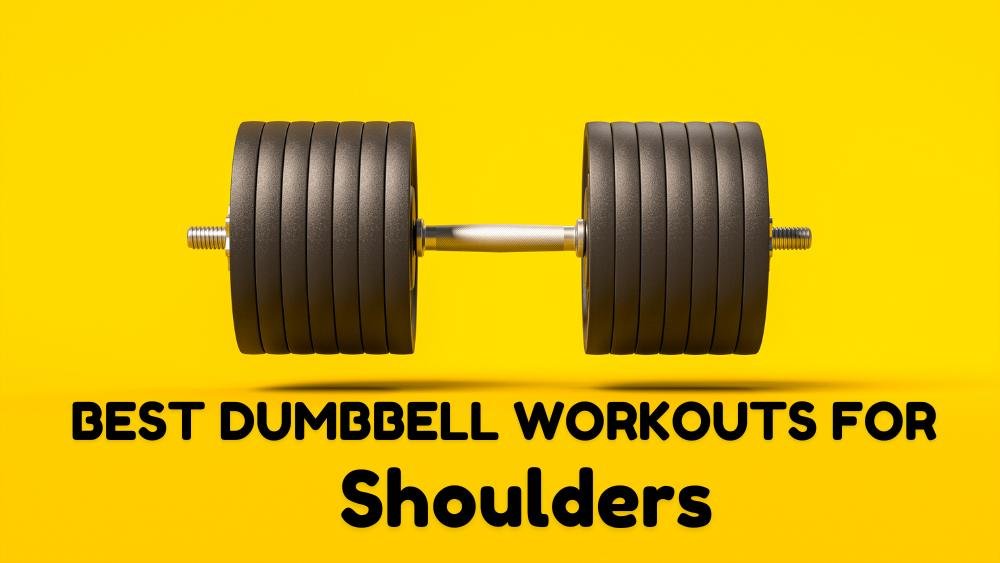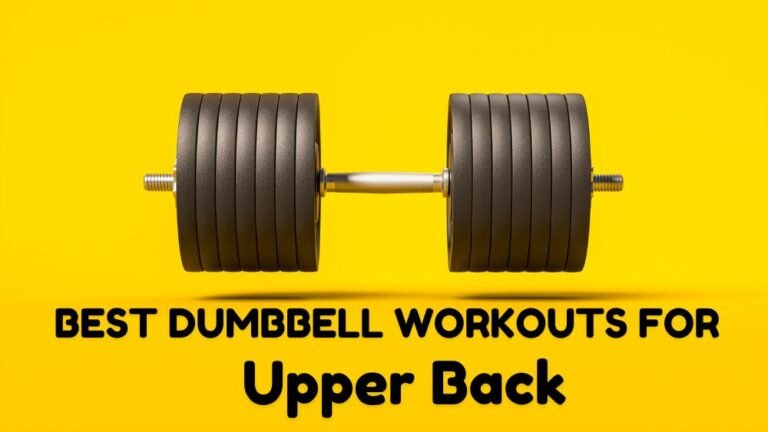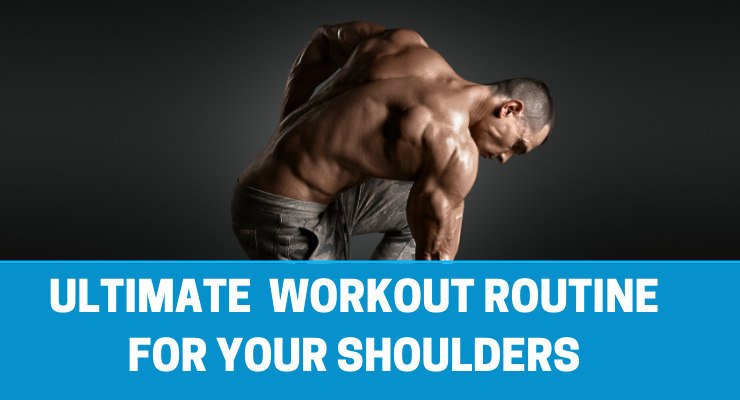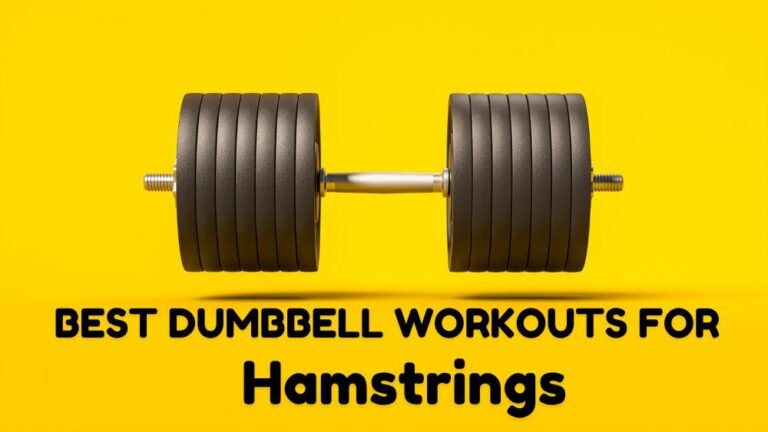10 Best Dumbbell Exercises for Sculpted Shoulders
When it comes to achieving a strong and sculpted upper body, well-defined shoulders play an essential role in creating an aesthetically pleasing silhouette.
Whether you’re an experienced fitness enthusiast or just starting your journey, incorporating targeted shoulder exercises into your routine can greatly enhance your physique and overall strength.
This article will explore a variety of dumbbell exercises specifically designed to shape and tone your shoulders, helping you to not only look your best but also improve your functional fitness.
Discover the importance of shoulder strength and how these exercises can contribute to your overall health and athletic performance.
Best Shoulders exercises with dumbbell
When it comes to sculpting well-defined shoulders, incorporating a variety of movements into your routine is crucial.
Focus on exercises that target all three heads of the deltoid muscle—anterior, lateral, and posterior—to guarantee balanced development.
Utilize different angles and grips to engage the muscles effectively, while also emphasizing proper form to prevent injury.
Combining these techniques with progressive overload will help you achieve that sought-after sculpted look, enhancing both strength and aesthetics.
Consistency is key, so make certain to include these shoulder exercises regularly in your workout regimen.
Dumbbell Shoulder Press
The Dumbbell Shoulder Press is a fundamental exercise designed to build strength and size in the shoulder muscles, primarily targeting the deltoids.
This compound movement not only engages the shoulders but also recruits the triceps and upper chest, making it a highly effective addition to any upper body workout.
With the right form, this exercise can help you achieve sculpted shoulders, improving both your aesthetics and functional strength.
To perform the Dumbbell Shoulder Press, follow these steps:
- Stand or sit with your back straight and feet shoulder-width apart, holding a dumbbell in each hand at shoulder height with your palms facing forward.
- Engage your core to stabilize your body, ensuring your spine is neutral.
- Press the dumbbells upward until your arms are fully extended overhead, without locking your elbows.
- Slowly lower the dumbbells back to shoulder height, controlling the movement throughout.
Dumbbell Lateral Raise
The Dumbbell Lateral Raise is a highly effective exercise targeting the deltoid muscles, particularly the lateral or middle head, which is essential for achieving sculpted shoulders.
This exercise not only enhances shoulder width but also contributes to overall upper body aesthetics and strength. Incorporating lateral raises into your routine can help improve shoulder stability and mobility, making it a staple for anyone looking to build a well-defined shoulder structure.
Execution of Dumbbell Lateral Raise:
- Stand upright with a dumbbell in each hand, arms resting at your sides and feet shoulder-width apart.
- Keep a slight bend in your elbows and engage your core to maintain stability.
- Slowly lift the dumbbells out to the sides, raising them to shoulder height while keeping your palms facing down.
- Pause at the top of the movement, then lower the weights back to the starting position with controlled motion.
Dumbbell Front Raise
The Dumbbell Front Raise is an effective exercise that targets the anterior deltoids, which are the front muscles of the shoulders. This exercise not only helps to build strength but also enhances shoulder stability and mobility.
Incorporating front raises into your workout routine can lead to well-defined shoulders, contributing to an overall sculpted upper body appearance. Additionally, this exercise helps improve posture by strengthening the muscles responsible for holding the shoulders back and down.
To execute the Dumbbell Front Raise properly, follow these steps:
- Stand upright with a dumbbell in each hand, arms resting at your sides, palms facing your thighs.
- Engage your core and keep your back straight throughout the movement.
- With a slight bend in your elbows, raise the dumbbells directly in front of you to shoulder height.
- Hold for a moment at the top of the movement, ensuring your shoulders are down and away from your ears.
- Lower the dumbbells back to the starting position in a controlled manner.
Dumbbell Arnold Press
The Dumbbell Arnold Press is a fantastic exercise for sculpting the shoulders, as it not only targets the deltoids but also engages the upper chest and triceps.
Named after the legendary bodybuilder Arnold Schwarzenegger, this exercise incorporates a unique rotation of the wrists and arms, allowing for a fuller range of motion compared to traditional shoulder presses.
By combining both pressing and rotating movements, the Arnold Press helps to build strength and muscle mass in the shoulder area while promoting stability and coordination.
To execute the Dumbbell Arnold Press effectively, follow these steps:
- Start by sitting or standing with a dumbbell in each hand, holding them at shoulder height with palms facing your body.
- Engage your core and maintain an upright posture.
- As you press the dumbbells overhead, rotate your wrists so that your palms face forward at the top of the movement.
- Slowly lower the dumbbells back to the starting position while reversing the wrist rotation, returning to palms facing you.
Dumbbell Reverse Fly
The Dumbbell Reverse Fly is an excellent exercise for sculpting the shoulders, particularly targeting the rear deltoids and upper back muscles. This exercise not only helps improve shoulder stability but also enhances posture, which is essential for overall upper body strength.
Incorporating the Dumbbell Reverse Fly into your routine can create a balanced shoulder appearance and prevent muscular imbalances that often arise from focusing solely on anterior deltoid exercises.
To execute the Dumbbell Reverse Fly effectively, follow these steps:
- Start by standing with your feet shoulder-width apart, holding a dumbbell in each hand.
- Bend your knees slightly and hinge at the hips to lean forward, keeping your back straight and your core engaged.
- With your palms facing each other, let the dumbbells hang down toward the floor.
- Keeping a slight bend in your elbows, raise the dumbbells out to the side until they’re at shoulder level.
- Squeeze your shoulder blades together at the top of the movement, then slowly lower the weights back to the starting position.
Dumbbell Push Press
The Dumbbell Push Press is an effective exercise for sculpting shoulders, combining strength and explosive power. This movement not only targets the deltoid muscles but also engages the triceps and upper chest, making it a compound exercise that promotes overall upper body strength.
By incorporating a slight leg drive, the push press allows for heavier weights to be lifted, which can lead to greater muscle hypertrophy and improved athletic performance.
To execute the Dumbbell Push Press correctly, follow these steps:
- Stand with your feet shoulder-width apart, holding a dumbbell in each hand at shoulder height with your palms facing forward.
- Engage your core and slightly bend your knees to prepare for the dip.
- Use your legs to drive up while simultaneously pressing the dumbbells overhead.
- Fully extend your arms at the top of the movement, ensuring that your elbows are locked out.
- Lower the dumbbells back to shoulder height in a controlled manner, maintaining a strong core throughout the movement.
Dumbbell Side-Lying Lateral Raise
The Dumbbell Side-Lying Lateral Raise is an excellent exercise for isolating the shoulder muscles, particularly the lateral deltoids. This movement not only helps in building strength but also enhances shoulder stability and improves overall upper body aesthetics.
By performing this exercise, you can achieve well-defined shoulders while minimizing the risk of shoulder injuries, making it a favorite among fitness enthusiasts looking to sculpt their upper body.
To execute the Dumbbell Side-Lying Lateral Raise effectively, follow these steps:
- Begin by lying on your side on a flat surface, ensuring that your head is supported by your lower arm while the other arm is holding a dumbbell.
- Keep your legs straight and stacked on top of each other, with your feet flexed.
- Inhale and, keeping your elbow slightly bent, raise the dumbbell away from your body until your arm is parallel to the floor.
- Hold the position for a brief moment at the top of the movement, then exhale as you slowly lower the dumbbell back to the starting position.
Dumbbell Cuban Press
The Dumbbell Cuban Press is an excellent exercise for sculpting the shoulders and enhancing overall shoulder stability. This movement combines elements of both rotation and pressing, effectively targeting the rotator cuff muscles as well as the deltoids.
By incorporating this exercise into your routine, you can improve shoulder mobility and strength, which is beneficial for both athletic performance and everyday activities. Additionally, the Cuban Press not only sculpts the shoulders but also helps in preventing injuries by strengthening the supporting muscles around the shoulder joint.
To execute the Dumbbell Cuban Press correctly, follow these steps:
- Begin by standing or sitting with a dumbbell in each hand, arms bent at 90 degrees, with palms facing your body.
- Rotate your forearms outward, raising the dumbbells to shoulder height while keeping your elbows at shoulder level.
- Once your arms are fully rotated, press the dumbbells overhead while maintaining a strong core and stable posture.
- Reverse the movement by lowering the dumbbells back to the starting position, rotating your forearms back to the initial 90-degree angle.
Dumbbell High Pull
The Dumbbell High Pull is an effective exercise for sculpting the shoulders, targeting the deltoids and trapezius muscles while also engaging the upper back and core.
This compound movement not only enhances shoulder stability and strength but also improves overall upper body power and coordination. Incorporating this exercise into your workout routine can help create well-defined shoulders, making it a favorite among fitness enthusiasts.
To execute the Dumbbell High Pull correctly, follow these steps:
- Stand with your feet shoulder-width apart, holding a dumbbell in each hand with an overhand grip (palms facing your body).
- Slightly bend your knees and hinge at the hips, keeping your back straight and your chest up, allowing the dumbbells to hang at arm’s length in front of you.
- Initiate the movement by driving your elbows upward, pulling the dumbbells close to your body, and raising them toward your chin.
- Make certain your elbows remain higher than your wrists throughout the pull, while keeping your core engaged and your shoulders down.
Dumbbell Around the World
The Dumbbell Around the World exercise is an effective way to target the deltoids and enhance shoulder definition. This movement mimics a circular motion that engages the muscles from different angles, promoting balanced strength and muscle growth.
By incorporating this exercise into your shoulder workout routine, you not only build muscle but also improve shoulder stability and mobility, which can be beneficial for various functional movements in daily life and other workouts.
To execute the Dumbbell Around the World exercise properly, follow these steps:
- Stand with your feet shoulder-width apart, holding a dumbbell in each hand at your sides.
- Raise the dumbbells in front of you, keeping your arms slightly bent, and begin to circle them outward in a wide arc.
- Continue the movement until the dumbbells reach shoulder height, then bring them back down and around behind your body.
- Complete the circular motion by returning to the starting position, ensuring that your core remains engaged throughout the exercise.
Anatomy of the Shoulders muscle
The shoulder muscles, primarily composed of the deltoids, play a significant role in upper body movement and stability. The deltoids are divided into three distinct parts: the anterior (front), lateral (side), and posterior (rear) deltoids, each contributing to a wide range of actions, including lifting, pushing, and rotating the arm.
Understanding the anatomy of these muscles is essential for effectively targeting them with dumbbell exercises.
In addition to the deltoids, the shoulder complex also includes the rotator cuff muscles and the trapezius, which work together to provide support and mobility. The rotator cuff consists of four muscles that stabilize the shoulder joint, while the trapezius helps in the movement and elevation of the shoulders.
Incorporating exercises that engage all these muscle groups is critical for achieving sculpted shoulders and preventing injuries.
Benefits of dumbbell Shoulders exercises
Dumbbell shoulder exercises offer numerous benefits, making them a staple in any fitness regimen. By engaging multiple muscle fibers and promoting stabilization, these exercises not only build muscle mass but also enhance functional strength, reducing the risk of injury during other activities.
The independence of each limb during unilateral training helps identify and correct any strength imbalances, ensuring well-rounded shoulder development.
Additionally, incorporating dumbbells into shoulder workouts greatly improves coordination. This enhancement in intermuscular and intramuscular coordination is essential for optimizing movement patterns and boosting overall athletic performance.
As a result, individuals can experience better joint stability and improved balance, which are vital for a wide range of physical activities.
Important training variables to consider
When planning your shoulder workouts, it’s essential to contemplate various training variables that can greatly impact your results. By focusing on these key factors, you can optimize your performance and sculpt those shoulders effectively.
- Repetition Range: Decide whether you want to build strength or endurance. Lower reps (4-6) target strength, while higher reps (12-15) enhance muscular endurance. Tailor your reps to your specific goals for better outcomes.
- Rest Periods: How long you rest between sets can influence your gains. Shorter rest (30-60 seconds) boosts endurance and metabolic stress, while longer rest (2-3 minutes) allows for muscle recovery and strength building.
- Volume and Frequency: Consider how many sets and workouts you’ll do each week. More volume (3-5 sets) can lead to better hypertrophy, while training frequency (2-3 times per week) guarantees you’re consistently challenging your muscles.
Sample Shoulders workout with dumbbell
To sculpt your shoulders effectively using dumbbells, it is crucial to incorporate a well-rounded workout routine that targets all three heads of the deltoid muscle: the anterior, lateral, and posterior. Below is a sample shoulders workout that combines various exercises to guarantee balanced development and strength. Aim to perform this workout 1-2 times a week, allowing for adequate rest and recovery between sessions.
| Exercise | Sets | Reps | Rest (seconds) |
|---|---|---|---|
| Dumbbell Shoulder Press | 3 | 10-12 | 60 |
| Lateral Raises | 3 | 12-15 | 60 |
| Front Raises | 3 | 10-12 | 60 |
| Bent-Over Dumbbell Flyes | 3 | 12-15 | 60 |
| Upright Row | 3 | 10-12 | 60 |
| Shrugs | 3 | 12-15 | 60 |
Remember to start with a weight that allows you to maintain proper form throughout the set, and gradually increase the weight as you become stronger.
Questions
How Often Should I Train My Shoulders With Dumbbells?
You should train your shoulders with dumbbells about two to three times a week, allowing at least 48 hours between sessions. This frequency helps build strength while giving your muscles time to recover and grow.
Can Beginners Perform These Dumbbell Shoulder Exercises?
Absolutely, you can perform these dumbbell shoulder exercises as a beginner. Start with lighter weights and focus on your form. Gradually increase the weight as you gain strength and confidence in your movements.
What Weight Should I Start With for Shoulder Exercises?
You should start with a weight that feels manageable but challenges you. Generally, beginners can use 5 to 10 pounds. Focus on form first; you can always increase the weight as you gain strength.
How Do I Prevent Shoulder Injuries While Training?
To prevent shoulder injuries while training, you should warm up properly, use correct form, avoid overloading weights, and listen to your body. Gradually increase intensity and incorporate rest days to allow for recovery.
Should I Warm up Before Shoulder Workouts?
Absolutely, you should warm up before shoulder workouts. Warming up increases blood flow, enhances mobility, and reduces injury risk. Spend at least 5-10 minutes on dynamic stretches or light movements to prepare your shoulders effectively.
Conclusion
Incorporating these 11 dumbbell exercises into your routine can transform your shoulders, helping you achieve that sculpted look you desire.
By targeting all parts of your deltoids and engaging supporting muscles, you’ll not only build strength but also enhance stability and coordination.
Remember to pay attention to important training variables to maximize your results.
Stick with it, and you’ll notice improvements in your shoulder aesthetics and overall athletic performance in no time!








